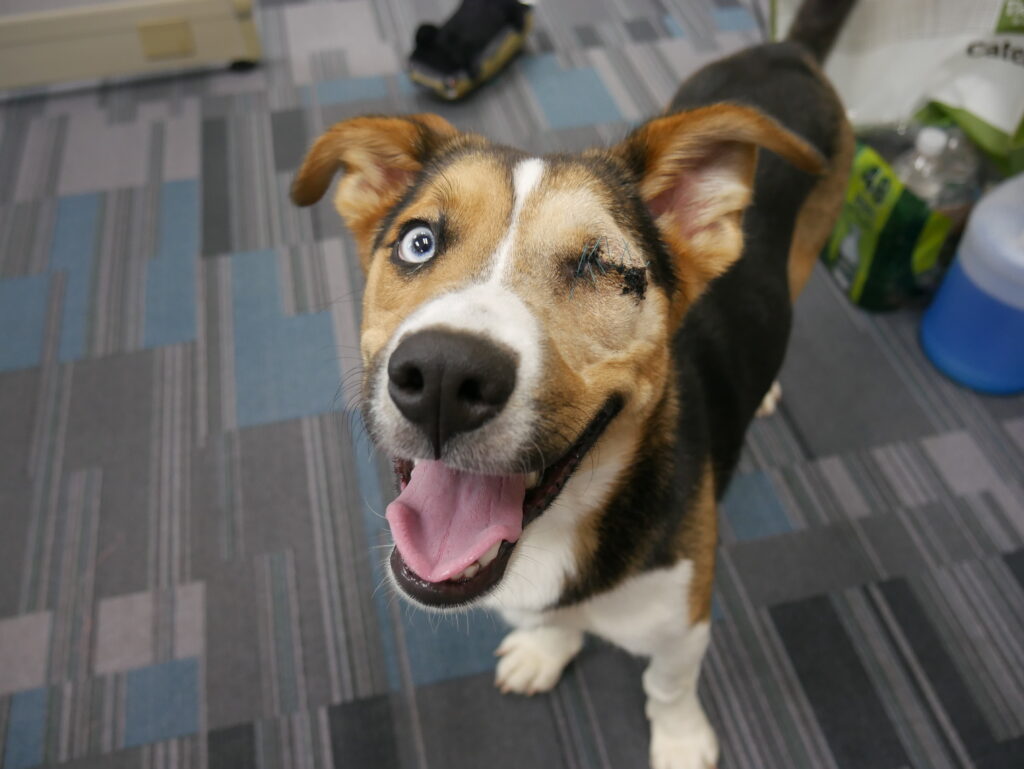
Sparrow was a 10-month-old puppy who came to HSPPR as a stray. When Sparrow arrived, we saw she had a severe eye injury that required immediate care. Our veterinary team removed her ouchy eye, and with a clean bill of health, Sparrow was ready for adoption!
Sparrow was adopted shortly after her surgery but was returned because of her separation anxiety. We tried a second time to find Sparrow a loving home, but the same thing happen. She returned a few days later because she didn’t like being alone.
When left alone or separated from an individual that they are most bonded to, some dogs will develop or experience separation-related anxiety. HSPPR’s Certified Behavior Consultant, Shelby Harvey, describes each type of anxiety, common myths associated with separation-related anxiety, and ways to try to work with your pup to make them feel more comfortable with alone time.
Separation-related anxiety is an umbrella term to cover three main stress conditions of dogs.
- Clinical Separation Anxiety: This occurs when a dog is separated from one (sometimes two) specific individual people. This means that even if a dog has the company of other humans, they will still display stress behaviors because their main bonded human is not nearby.
- Isolation Anxiety: This is the most common form of separation-related anxiety. This occurs when a dog is left completely alone. The absence of human presence can trigger stress behaviors since the dog feels isolated.
- Containment Anxiety: A lot of dogs that suffer from the first two types of separation-related anxiety also experience stress during containment. This is most prominent in dogs who experience stress while crating or kenneling.
Canines experiencing separation-related issues can display anxious behaviors, such as excessive vocalizations (whining, barking, howling), pacing, destructive tendencies, chewing on walls or doors, or many other stress behaviors. It may be easy to see that there is stress occurring for your dog, but it can be a lot harder figuring out how to help them feel better when alone. Before going into what we should do, here are some common myths of separation anxiety in canines.
Common Myths
- Spoiling your dog creates separation anxiety. There is no research supporting the claim that spending valuable bonding time with your pup creates separation anxiety. If you are trying to solve your dog’s stress induction, then withholding attention and care from your dog will most likely just add more stress to their lives.
- Being an ‘Alpha’ leader of the pack or using positive punishment will solve bad behaviors. We’ve talked about how alpha-based or positive punishment-based training can make behaviors worse and causes a huge rift in the trust between you and your pup pal. Click here to learn more.
- Your dog is being destructive or ‘bad’ out of spite deliberately. Many times, owners can tend to think that their dog is acting inappropriately to get back at the owner for upsetting them. This myth is especially prominent in dogs that have destructive tendencies when experiencing stress. The truth is that a dog’s brains don’t really comprehend revenge or spite. Chewing items can either be a way to self-calm themselves, or they are trying to create an exit point, so they don’t have to be alone anymore.
- Letting your dog cry it out will help decrease the behaviors. This technique will only compound a dog’s anxiety. Like the above myths, ignoring (purposely or passively) the stress that your dog is experiencing will most likely either continue the issue or make the behaviors worse.
Treatment
The good news is that separation-related anxiety behaviors are treatable! The most productive and efficient treatment for these behaviors utilize a certified, professional dog trainer while also working with a veterinarian to manage anxiety levels. Click here for HSPPR’s Behavior Resource Guide and to find a local, certified professional dog trainer.
*The following tips below are only to be used for temporary support, until an appointment with a certified, professional dog trainer is made.
- Try to not leave the dog alone for long enough periods that induce anxiety. It may be understandably hard to keep up with being tied to a dog for 24/7 if they experience stress as soon as you leave. Consider utilizing doggie daycares, pet sitters, friends, and family to help your pup fend off anxiety attacks from feeling isolated.
- Meet with your veterinarian to explore any underlying medical conditions and discuss medications that can help your dog’s anxiety levels. This can be helpful to do with a trainer, since they can help advocate for your dog and present a full behavior history in a professional manner. In the words of separation anxiety expert Malena DeMartini, medication should be a first resort, not a last resort.
- Slowly, start to have your dog experience some brief periods of alone time. The most important obstacle when helping your dog feel more comfortable alone is to focus on short time frames that the dog does not panic during. Make sure to provide enrichment items and structure alone time to be in a calming environment. A certified trainer can help you with these desensitization methods, so you and your dog can have support through this process.
As for our pirate friend Sparrow, we are still working on finding her the perfect home. She needs a family willing to work with her, make her feel comfortable, and show her that “me time” is actually a good thing!







